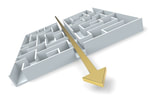 The journey in Direct Care is unique to you. If you're someone who values work-life balance then you've come to the right place. In Direct Care, you control your model. With a simple micropractice style model, like I've owned for the last seven years with my partner, you can achieve this balance with a few boundaries and goals in mind. When you begin your DPC it is key to understand your calculations right off the bat. How many patients do you need? The math is simple. You combine the salary you desire with the hours you'd like to work. (1) Estimate your overhead so you can deduct that from your practice income. (2) Use your approximate desired salary to calculate the number of patients you need to carry. (3) Use the patient utilization estimator to determine the number of hours you need to work in the office. (4) Decide if you plan to have staff to fill in the non-complex patient need hours. (I have no staff - our office has close to 1000 patients and 3 docs, so I encourage everyone to try it this way and reach out when you're feeling the need to add staff so I can help advise you on how to improve your efficiency and keep it staff-free!). When I use the calculators above, a doctor at our practice requires 27 in office hours per week for 48 weeks per year to meet the demand of his or her 370 patients and come home with $250,000 in annual salary. At 27 hours per week, that doc is in-house 3 full days or 4-5 part-time days. I have become accustomed to a 3 day work week and prefer to use 1-2 hours on my "at-home days" to work on remote issues/administrative tasks that come up on those days. I am able to do the administrative tasks associated with the patients I've seen in the office between visits. (More on how I structure my day coming in future blogs!). If you're finding it hard in your existing practice (or in your start-up using the numbers I have provided in the calculators) to make the numbers work with a work-life hours balance, I suggest considering which of the following areas could be adjusted: - Overhead: how can you cut back ancillary expenses? Think about what is required for excellent clinical care and access to you as a physician, and see what things are not meeting those aims and could be reduced or eliminated? Medication inventory may be a good place to consider cutting, especially if it's overwhelming you financially and is time-intensive. - Income: have you adjusted prices or added a sign-on fee to increase your averages? Are you being paid well enough to sustain what you're doing? - Enjoyment: is it that you're taking on a certain type of patient care that isn't fulfilling or is labor-intensive and could you make any adjustments in your marketing pitch or boundaries to improve this for yourself? - Find the middle ground: perhaps you can't make it work in under 32 hours, but you also don't need to do 40 hours. Somewhere in there is the right balance for you - play with what adjustments you can make and find the perfect balancing act. - Flex scheduling: use your own scheduler (I love the online scheduling features in our EMR) to block time when you start to feel over-worked, to buffer your day with time to complete admin work, and with "personal days" here and there to catch up or take time off! The goal of Direct Care Lite is to be on a financially and personally better track during your career so that you can comfortably retire when you're eventually ready but you can comfortably enjoy your work and your life now with happiness throughout career. If you feel stuck or way off track, consider reaching out to me for help on how to make some improvements!  No two direct care practices are created equal. If you're debating how to begin your DPC, there are many blog posts that will discuss the basics of direct care, how to open a Direct Care Lite practice, and the nuts and bolts of startup costs. (There are also some amazing and inspiring podcasts to help you start your practice). If you have a game plan or are deep into your own practice (which might be months or even years in), this post is meant to help you identify the best ways to "troubleshoot" the issues you find you are having day-to-day. Our DPC is a micropractice (think no staff) with an emphasis on simplicity and low overhead. In our case, we find I advocate the "step-back and analyze" point of view. In other words, look ahead a few days, a few weeks on your work schedule and block out a few days entirely. (If your practice is like mine, you can spend an hour or two a day on those days handling things that arise that are urgent for patients and using the rest of your time to analyze your practice). When you are knee-deep in daily practice and seeing a full panel of patients, your efforts to make changes are unlikely to work because the urgent needs of the patients you are seeing will take over (as it should). Hence, I strongly advocate taking time off from seeing patients and doing a full review of your practice. If you know of an issue with your practice that you want to fix, start there. If you just want to do an overview of your practice and shore up some improved procedures to save time and money then consider a more general review. When you are focusing on a single issue here are some factors to consider: - Why is this a problem? For me or patients? And therefore, is the issue time or money related or is it simply causing unnecessary frustration? - Time related: how can this be done using less time? - Cost related: how can this be done with less expense? - Frustration related: why is this bothering me or my patients and is there another way to do it? Here are a few case studies of these concepts. CASE 1: I have patients calling, texting and emailing me all day during the work day and I cannot see patients and respond to others at the same time. I want to maintain no/low staff so how do I handle this? When you step back and look at this issue, you want to decide what is YOUR preference. Do you prefer patients text, email or call? Do you prefer to handle issues (that are clinically safe to do so) remotely or do you prefer to have patients come in for a visit? Many practices evolve to allow patients to contact you via all of these methods and each patient does not have a clear view of what the physician prefers. Managing all avenues can be overwhelming. So, this practice should pick their preference for weekdays and for after hours. - In my practice, patients can send an after hours email for things that can be handled during work days and I will manage those in between patients during my work hours. - Patients can text me during regular works hours or email via the private patient portal. I have scheduled a buffer of 15-30 minutes that I enter myself on my scheduler (which is part of my EMR) so that after and before patient visits I have time to handle visit-related tasks and/or respond to texts and emails. - If a patient sends a non-urgent text after hours, I send it to myself in email form and manage it during the week. I also send a gentle reminder for repeat offenders that email over the weekend/overnight is ideal for non urgent issues so I don't lose the text by the next work day. - When I determined these rules help me the most, I sent this to my patients in a brief email so that they could refer back to the best ways to reach me when they weren't sure! CASE 2: I can't get through all this paperwork! First of all, big step back - what paperwork? At our practice we've really eliminated paper about 98% of the time. I urge you to review what paperwork you use that is wasting your time - filling out forms, signing, scanning, shredding, filing, etc. Examples of switches to electronic options: - Switch your sign up forms to an online format (most patients can sign a pdf on their phones so we email a link with forms to them from our website and they email back); there are tech-savy options like DocUSign, etc but because money is money, we go the free route! - Change your medical records request to FAX only (eliminating the address has dropped the number of paper charts we get by about 90-95%). - Set up an electronic fax that integrates directly into your EMR so it's a one stop shop. If you have to file away prior charts, sign and send a form and then save it in the EMR, or complete paperwork and keep it on file - an e-fax/EMR connection does it all without any printing/scanning/filing/envelopes/stamps/you get the point! - Scanning and shredding are the single most time consuming things I did early in practice - switch to electronic but if you must have paper, get a high speed scanner that can run a lot of pages at once and invest in a shredding service. We have one big bin outside the office and it gets replaced twice a year - that is the best $130 per year we spend in time-savings! - Review your paper problems and decide where you can improve tech to save yourself time and money! I'd love to help you brainstorm and troubleshoot so shoot me an email and I will write a blog about your problem or if it's more complex, talk to me about consulting directly to help you break your problem down and make your practice work. Remember - if the practice is not sustainable for you, then it is not going to be around to help patients, hire staff, etc so if you suffer, everyone suffers. It's not too late to make a working change! More on the nuts and bolts of starting or improving your Direct Care practice... While time is money, money is also money. Loving and living in your Direct Care practice does not have to mean spending more than you earn to keep the lights on. It does not require a massive startup budget. It requires some careful planning, and maybe a good spreadsheet or two! The best advice I can give is pick and choose what you NEED and start there. You can always add wants and maybes down the line.
Here is what you don’t need to keep your practice running smoothly:
What you do need to start is simple:
What you might need:
Your practice has to be right for YOU but taking baby steps when it comes to footing the bill is the smartest way to build a simple, sustainable practice without adding new burdens to your life. Read more about what forms you need to start your Direct Care practice...  My husband, and fellow doc, wowed me with his dedication to lightweight backpacking when I met him almost 15 years ago during anatomy lab. He had recently hiked a large portion of the Appalachian trail (A.T.), a hike that runs from GA to ME, coursing over 2000 miles of terrain. He started his hike with a 60 lb pack full of all the gear he believed he required and reduced it to 8 lbs as he realized that everything he carried with him was a burden his shoulders alone could bare. In 2014, I started my Direct Care journey with the model of lightweight backpacking and The Ideal Medical Practice as my guiding principal. Picture one guy hiking the A.T. carrying his 60 lb pack on his shoulders. He is slower, more burdened and less likely to succeed than his counterpart, skipping along with an 8 lb pack. He can switch to a side trail or move around an obstacle blocking his path with ease. He's flexible and nimble. Direct Care, mostly in the form of Direct Primary Care, is taking the medical world by storm. More and more physicians burn out of being managed and manhandled by corporate-non-medical bosses and insurance-dictated standards. Direct Care is doctors' medicine for what ails us. A way to regain passion for medicine, connection with patients, and the satisfaction of controlling your own destiny makes this model a winning career change for many. But, you worry about personal costs, a lack of protection, issues of loan forgiveness and a lack of support - all thanks to the golden handcuffs you've become used to wearing. Break away with your 8 lb pack. Start your Direct Care practice without these fears. Remove the assumption that you need to spend a lot to start your practice; that you need to hire staff; that you need to take out loans; that you need to build out your office space; and that you can't work without the support of others. The smaller the burden of overhead and startup costs that you carry on your back, the less of a heavy leap it will take to make your first footsteps. The Direct Care (lite) model - aka micropractice, aka Ideal Medical Practice, aka low overhead, aka low or no staff model of care - is simple, intentionally. The less your overhead, the quicker to pay yourself, the more pay per hour worked, and the larger the percentage of every new patient membership stays in your pocket. The sooner you learn that patients aren't buying your expensive marketing, your fancy build out, your high-end table, or your personalized pharmacy, the sooner you realize they are paying for YOU. Access to Direct Care docs is unprecedented and unmatched in the Fee For Service world. You are valuable and you are the value proposition. All you NEED is who you are - you've already invested so much time and money into becoming Dr. YOU - now you owe it to yourself to value that as your patients already do. |
AuthorI am a Family Physician, wife to a doc, and mother of three with a mission to convince you as a doctor that you are worth more than the system is giving you and that you are already well-equipped to make a big change without adding more burdens! My passion is helping existing or start up Direct Care practices learn to troubleshoot, streamline, and simplify. Categories
All
Archives
February 2024
|
 RSS Feed
RSS Feed